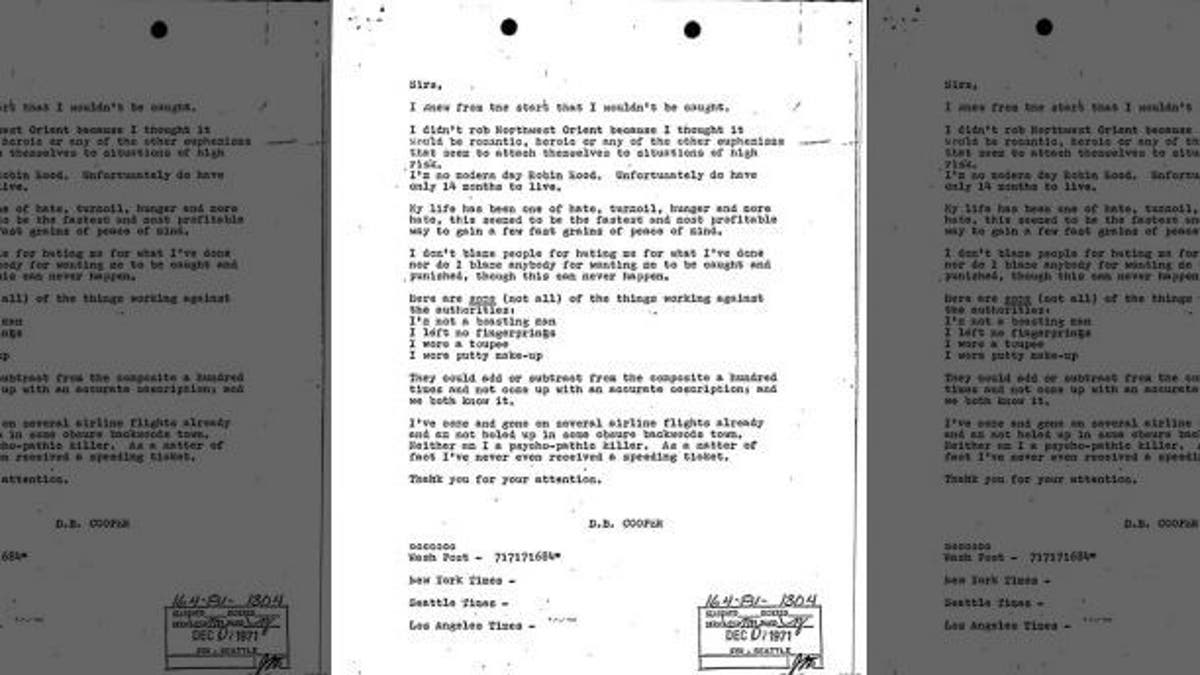DB Cooper sleuth insists letter written by mysterious hijacker linked to San Diego man
{{#rendered}} {{/rendered}}A nine-digit number found at the bottom of a letter believed to be sent by the mysterious plane hijacker D.B. Cooper came from a San Diego man who is still alive, the leader of an investigative team said.
Thomas Colbert, a TV producer who helped put together the 40-member team, told Seattle PI on Thursday that the person’s name is Robert Rackstraw, an Army veteran.
The code was discovered on the bottom of a fifth letter allegedly sent by Cooper after he hijacked a Northwest Orient Boeing 727 on Nov. 24, 1971, according to Seattle PI.
{{#rendered}} {{/rendered}}Colbert told the newspaper that the man who sent the letter may have put the code into the letter to signal to possible co-conspirators that he was alive.
Colbert claims that the code refers to three specific Army units Rackstraw was connected to during his military service. One of Rackstraw’s former commanders told Colbert that Rackstraw would have learned some encryption codes before being pulled from the unit, according to Seattle PI.
“I think the coding thing is remarkable, but I'm a hard skeptic,” Dorwin Schreuder, a former FBI agent who worked on the Cooper mystery in the 1980s, told Seattle PI. “The circumstances of those codes being what Tom says they are, that he says nobody but him would know these units and these figures, if it's true that's pretty hard to argue against. Rackstraw might be his guy.”
{{#rendered}} {{/rendered}}The FBI released the fifth letter in November, which featured the typed number “717171684” opposite the name “Wash Post” in the bottom left corner. Colbert’s team appeared to have linked the number to Rackstraw.

The letter allegedly written by DB Cooper and sent to The Washington Post.
The digits Cooper allegedly inscribed next to "Wash Post."
Investigators questioned Rackstraw about the Cooper case in 1978 and eliminated him as a suspect.
In March 2017, Rackstraw sent the judge presiding over Colbert’s FOIA lawsuit against the FBI a rambling 9-page letter that the judge took to be a motion to intervene in the case. In his letter, Rackstraw said that he was not D. B. Cooper and accused Colbert of ruining his life.
{{#rendered}} {{/rendered}}The judge responded to the letter by issuing a ruling that rejected Rackstraw's motion.
Later that July, Rackstraw sent another letter to the court in which he again said he was not the hijacker.
In 1971 — the night before Thanksgiving -- a man calling himself Dan Cooper, wearing a black tie and a suit, boarded a Seattle-bound Boeing 727 in Oregon and told a flight attendant he had a bomb in a briefcase. He gave her a note demanding ransom.
{{#rendered}} {{/rendered}}After the plane landed he released the 36 passengers in exchange for $200,000 in ransom money and parachutes. The ransom was paid in $20 bills.
The hijacker then ordered the plane to fly to Mexico, but near the Washington-Oregon border he jumped and was never seen or heard from again.
Nine years later a boy found a rotting package full of $20 bills near the Columbia River on the same border. The $5,800 matched the ransom money serial numbers.
{{#rendered}} {{/rendered}}The FBI has never ruled out the possibility that the hijacker was killed in the jump -- which took place in a rainstorm at night, in rough wooded terrain. The hijacker's clothing and footwear were also unsuitable for a rough landing.
Over the years the most lasting image of Cooper, who became somewhat of a legend, may be the two sketches the FBI released of the suspect.
Fox News’ Robert Gearty and the Associated Press contributed to this report.

